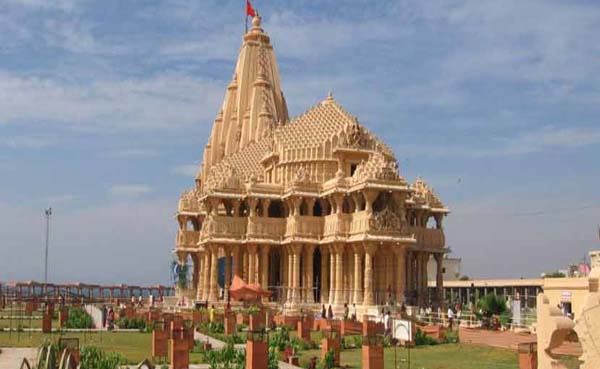Dwarkadhish Temple

Information of Dwarkadhish Temple, Devbhoomi Dwarka, Gujarat
The Dwarkadhish Temple is also alternatively known by the name of Jagat Mandir and at times is spelled as "Dwarakadheesh". The temple is devoted to Lord Krishna who is referred to as Dwarkadhish here and is a revered temple among Hindus. The temple is situated in the Dwarka city of Gujarat, India. The main place of worship or temple of the building with five floors is held up with the aid of 72 pillars and is referred to as the Nija Mandir or the Jagat Mandir. It has been learnt though various archaeological researches that the main shrine dates back 2000 to 2200 years.
Dwarkadhish Temple Religious Significance
The Dwarakadheesh Temple in Dwarka is considered to be greatly imperative with regard to the religious view point. It is known to be amongst the four main sacred centres for pilgrimage in the country as per the Hindu Religion. The mentioned four main places that are known to be the pilgrimage centres or rather 'Dhams' in the country are Jagannath Puri, Rameshwar, Badrinath and Dwarka. The Dwarakadheesh Temple is further acknowledged to be amongst the seven 'Moksha Puris' according to the Hindu Religion. The following are among the striking features and significance of the temple. The Sun and the Moon are represented by the flag on top of the temple which is changed five times in a day but there is no change in the symbol. There are seventy two pillars on which the five storeys of the temple rests, the total height spanning to 78.3 metres. The primary raw material used in construction of the temple is limestone and is still in a good condition. The interiors of the temple have intricate designs depicting the various dynasties who ruled the area at various points of time. The temple has two entrances. The Northern entrance is the main entrance and is known as Moksha Dwara or the Door to Salvation. The main market can be reached through this entrance. The other door which is towards the south of the temple is known as Swarga Dwara or Gate to Heaven.
Dwarkadhish Temple Mythology & History
Dwarka is known to be the Lord Kirishna's capital and the temple is positioned on the embankment of Gomti river. It is said that the actual Dwarakadheesh Temple was constructed by Vajranabha who was the grandson of Lord Krishna in the period of 400 BC. The temple was constructed above the home of Lord Krishna. After Adi Shankaracharya, the Hindu philosopher and theologian visited the temple during 8th century, the temple became a part of the sacred Char Dham. A memorial still exists inside the temple in memory of his visit. It is considered to be the 108th Divya Desam (i.e. temples of Vishnu as mentioned by the Tamil saints or Ashvars).
During the ancient age, the recent Dwarka was actually referred to as Dwaravati or Kushasthali and enjoyed the reputation of being one of the most significant places along the coast of Saurashtra. According to the mythological traditions, it is believed that after killing Kansa, Lord Krishna left his home at Mathura and journeyed to the Saurashtra coast along with the whole community of Yadavas and established a new town in the name of Swarnadwarika. It is ardently supposed by several Hindus that the Dwarakadheesh Temple was built by a mystic force in just a single night in compliance with the instructions of Vajranabh.
- Andhra Pradesh Temples
- Assam Temples
- Bihar Temples
- New Delhi Temples
- Goa Temples
- Gujarat Temples
- Jammu and Kashmir Temples
- Karnataka Temples
- Kerala Temples
- Madhya Pradesh Temples
- Maharashtra Temples
- Odisha Temples
- Punjab Temples
- Rajasthan Temples
- Sikkim Temples
- Tamil Nadu Temples
- Telangana Temples
- Uttar Pradesh Temples
- Uttarakhand Temples
- West Bengal Temples